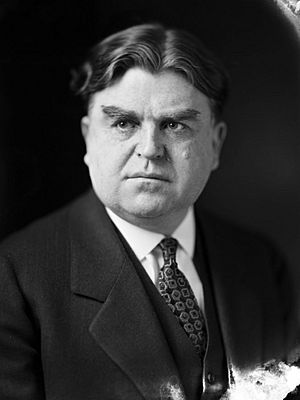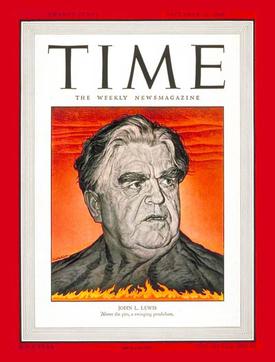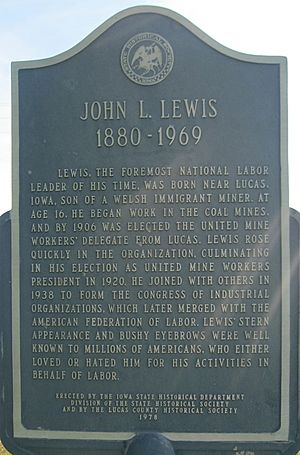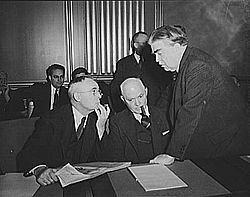John L. Lewis facts for kids
Quick facts for kids
John L. Lewis
|
|
|---|---|

Lewis in c. 1927
|
|
| 9th President of the United Mine Workers | |
| In office 1919–1960 |
|
| Preceded by | Frank Hayes |
| Succeeded by | Thomas Kennedy |
| 1st President of the Congress of Industrial Organizations | |
| In office 1936–1940 |
|
| Preceded by | new organization |
| Succeeded by | Philip Murray |
| Personal details | |
| Born |
John Llewellyn Lewis
February 12, 1880 Cleveland, Lucas County, Iowa, U.S. |
| Died | June 11, 1969 (aged 89) Alexandria, Virginia, U.S. |
| Political party | Republican |
| Spouses |
Myrta E. Bell
(m. 1907; died 1942) |
| Children | Margaret Mary, Kathryn, and John, Jr. |
| Occupation | Miner, labor leader |
John Llewellyn Lewis (born February 12, 1880 – died June 11, 1969) was an important American leader for workers. He was the president of the United Mine Workers of America (UMW) from 1920 to 1960. This union helped coal miners.
Lewis also helped start the Congress of Industrial Organizations (CIO). This group helped millions of factory workers get organized in the 1930s, during the Great Depression. He was a strong leader who fought for better pay and benefits for his union members.
Even though he was a Republican, Lewis helped Franklin D. Roosevelt, a Democrat, win the US Presidency in 1936. Lewis was known for his powerful voice and strong personality. Many coal miners saw him as a hero. They believed he brought them higher wages, pensions, and medical care.
Contents
Growing Up and Becoming a Leader
John L. Lewis was born in Iowa. His parents were immigrants from Wales. His family lived in a "company town" built around a coal mine. He started working in a mine at age 17.
In 1906, Lewis became a delegate for the United Mine Workers (UMW). This meant he represented miners at their national meeting. In 1909, he became president of his local UMW group in Panama, Illinois.
In 1911, Samuel Gompers, the head of the American Federation of Labor (AFL), hired Lewis. Lewis became a full-time union organizer. He traveled around the country, helping workers in coal and steel areas to form unions.
Leading the United Mine Workers
Lewis became the acting president of the UMWA in 1919. On November 1, 1919, he called a big strike. About 400,000 miners stopped working. President Woodrow Wilson ordered them to go back to work. Lewis told the miners to obey the government.
In 1920, Lewis was elected president of the UMWA. He quickly became a very important figure in the union. It was the largest and most powerful union in the country at that time. Lewis took strong control of the union. He wanted to make sure the union was united and strong.
Lewis was a powerful speaker and a smart planner. He used the country's need for coal to get better wages and safer conditions for miners. He even did this during tough economic times. In 1921, Lewis tried to become president of the AFL, but he lost to Samuel Gompers.
In 1924, Lewis, who was a Republican, suggested a three-year contract for miners. It would give them $7.50 a day. President Calvin Coolidge and Herbert Hoover liked his idea. Lewis was even offered a job as the Secretary of Labor, but he said no.
The Great Depression and New Opportunities
During the Great Depression, many people lost their jobs and struggled. Lewis supported Franklin D. Roosevelt for president in 1932. In 1936, his union gave a lot of money to Roosevelt's campaign.
Lewis worked with the government to help miners. He used Roosevelt's popularity to encourage miners to join the UMW. He told them, "The President wants you to join the UMW!" This helped the union grow very quickly.
He also helped pass laws like the Guffey Coal Act. These laws helped raise prices and wages in the coal industry. Lewis believed that a strong union could help make the coal industry more stable. He always supported capitalism and competition, not socialism.
Starting the CIO
In 1934, Lewis convinced the AFL to support "industrial unionism." This meant organizing all workers in an industry, not just skilled workers. Lewis wanted to organize steel workers.
In 1935, Lewis and leaders from nine other unions formed the "Committee for Industrial Organization." Their goal was to organize workers across whole industries. This group later became the Congress of Industrial Organizations (CIO) in 1938. Lewis was its first president.
The CIO grew very fast in industries like steel, rubber, and cars. In 1937, the CIO won important contracts with big companies like General Motors and United States Steel. This made the CIO very powerful and respected.
Lewis's Powerful Speeches
John L. Lewis was famous for his powerful speeches. He often used strong words to convince people. For example, he would talk about miners' families needing food. He would say they were "asking only for a slim crust of bread," not fancy cars or yachts like the company owners had. This often shamed owners into agreeing to contracts.
During World War II

In the 1940 presidential election, Lewis did not support President Roosevelt. He supported the Republican candidate, Wendell Willkie. Most union members, however, still voted for Roosevelt. After this, Lewis resigned as president of the CIO, but he stayed in charge of the UMWA.
Before the attack on Pearl Harbor, Lewis did not want the United States to join World War II. He thought getting involved in the war was like fascism. After the attack on Pearl Harbor in December 1941, Lewis fully supported the government. He said all Americans must help the nation.
However, in 1943, Lewis led coal strikes. This caused problems for the country during the war. Many people were upset with Lewis because they felt the strikes hurt the war effort. Polls showed that most Americans did not approve of his actions at that time.
After the War
After World War II, Lewis continued to be a strong leader. His miners often went on strikes. President Harry S. Truman said these strikes threatened the country. Because of the strikes, many industries started using oil instead of coal.
Lewis also pulled the UMWA out of the AFL. He refused to make his union officials sign promises that they were not Communists. This was required by a new law called the Taft–Hartley Act. Lewis believed this law gave the government too much power over unions.
In 1950, Lewis signed a new contract with coal companies. This agreement ended strikes and brought better wages and medical benefits for miners. The union even built hospitals for them.
The 1950s and Retirement

In the 1950s, Lewis kept getting pay raises and benefits for miners. He also helped pass the first Federal Mine Safety Act in 1952. This law made mines safer.
However, new machines meant fewer jobs in the mines. Lewis tried to keep standards high for his members. He made sure small companies agreed to union terms, even if it meant some went out of business.
Lewis retired in 1960. The number of union members had dropped because of machines and competition from oil. He was replaced by Thomas Kennedy, and then by W. A. Boyle.
Later Years and Legacy
On September 14, 1964, Lewis received the Presidential Medal of Freedom. This is a very high honor given by the President of the United States.
Lewis lived in Alexandria, Virginia, until he passed away on June 11, 1969. Many people remembered him fondly. Even those who had disagreed with him praised his work. They said he made coal miners "the best paid and best protected miners in all the world." He is buried in Oak Ridge Cemetery in Springfield, Illinois.
See also
 In Spanish: John L. Lewis para niños
In Spanish: John L. Lewis para niños
- Labor history of the United States
- New Deal Coalition
- UMWA predecessors:
- Michael Ratchford
- John Mitchell (United Mine Workers)
- Thomas Lewis
- John Phillip White
Images for kids
-
Time magazine showed John L. Lewis on its cover in 1946.
-
Lewis meeting with mine workers at a rally in Shenandoah, Pennsylvania.







